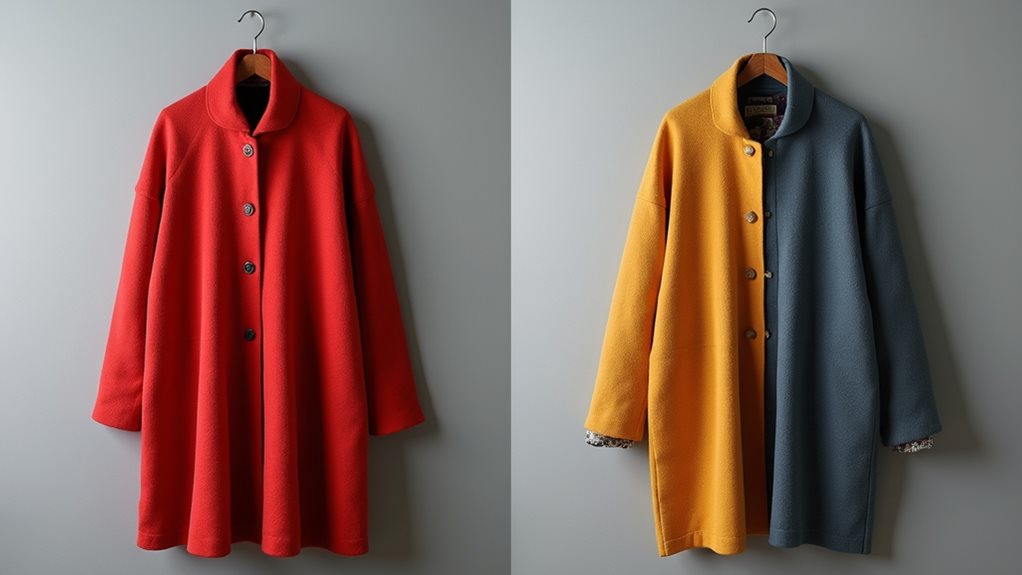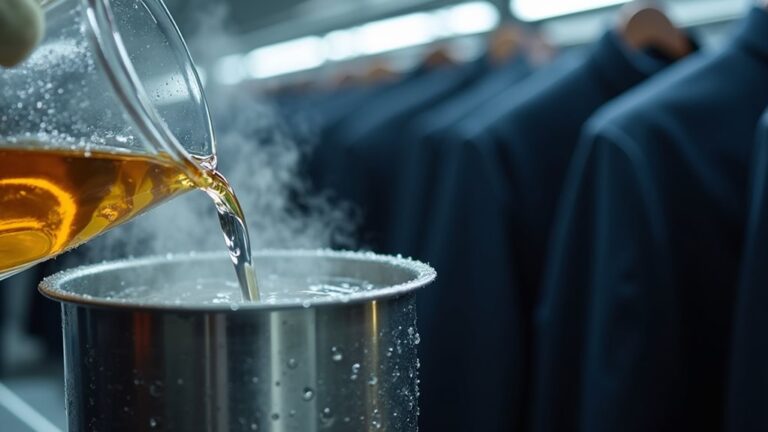Dry cleaning can absolutely help preserve your garment’s colors, but it’s not a foolproof guarantee – the magic lies in those gentle, non-water solvents that don’t strip dye molecules like your washing machine’s aggressive detergents do. However, you’ll want to choose your cleaner wisely, because dirty, overused solvents can actually extract colors from your favorite pieces, leaving them looking dull and lifeless. Understanding the nuances behind solvent quality will transform how you protect your wardrobe.
How Dry Cleaning Works to Preserve Color
When I first started taking my favorite silk blouse to the dry cleaner, I honestly thought it was just an expensive way to avoid doing laundry myself 😅, but after watching my colors stay vibrant wash after wash, I realized there’s actual science behind why dry cleaning preserves your garments’ appearance so beautifully.
Here’s how dry cleaning works to keep your clothes looking fresh: professional cleaners use specialized non-water-based solvents that don’t interact chemically with fabric dyes, preventing color fading that typically happens with traditional washing.
The solvents used gently lift stains and odors without the harsh agitation of washing machines, while pre-spotting techniques target specific problem areas without damaging surrounding fabric.
This careful process extends the life of your clean clothes considerably. Unlike water-based washing that can cause color bleeding and runs, chemical solvents like perchloroethylene help prevent the temperature extremes and agitation that damage fabric dyes.
The Science Behind Fabric Dye Protection

While I used to think fabric dyes were basically permanent once they set into clothing, my deeper exploration into dry cleaning science revealed that protecting those vibrant colors involves a fascinating chemical dance between solvents and dye molecules that honestly made me appreciate my cleaner’s expertise even more.
The intricate chemistry behind dry cleaning’s dye preservation turned my casual appreciation into genuine respect for professional garment care expertise.
You see, dry cleaning solvents like perchloroethylene don’t chemically react with fabric dyes, which prevents that heartbreaking color fading we’ve all experienced with water-based washing.
The gentle cleaning process protects garment integrity by minimizing mechanical agitation that can literally shake dye molecules loose from fibers.
Professional cleaning solvents stay crystal clear, guaranteeing effective stain removal without contamination that dulls colors, ultimately helping extend the life of your favorite pieces while maintaining their original vibrancy.
This protection is especially crucial for delicate fabrics like silk and wool, which are particularly susceptible to damage from traditional water-based washing methods.
Why Water-Based Washing Causes Color Loss
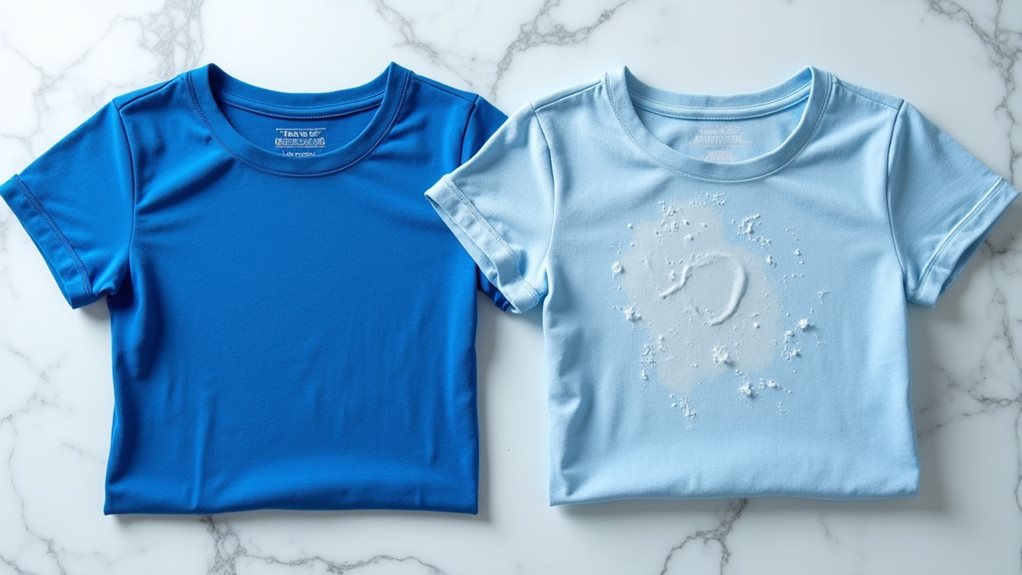
Understanding this protective power of dry cleaning becomes even more meaningful when you contrast it with the harsh reality of what happens during regular water-based washing, where I’ve watched countless beloved garments lose their luster despite my best intentions.
When you toss delicate fabrics into your washing machine, the aggressive agitation creates friction that literally beats the dyes out of your clothes, while hot water acts like a color-stealing accomplice that accelerates fading faster than you’d imagine.
Your trusty laundry detergent, packed with enzymes and surfactants, strips away those precious dyes like an overzealous cleaning crew. The soaking process causes color migration, creating uneven patches, and fabric swelling loosens dye bonds permanently.
Unlike water-based washing, dry cleaning uses chemical solvents that effectively clean without compromising the delicate dye bonds that keep your clothes looking vibrant.
It’s honestly heartbreaking watching vibrant colors become sad, washed-out versions of themselves!
Fabrics Most Susceptible to Fading
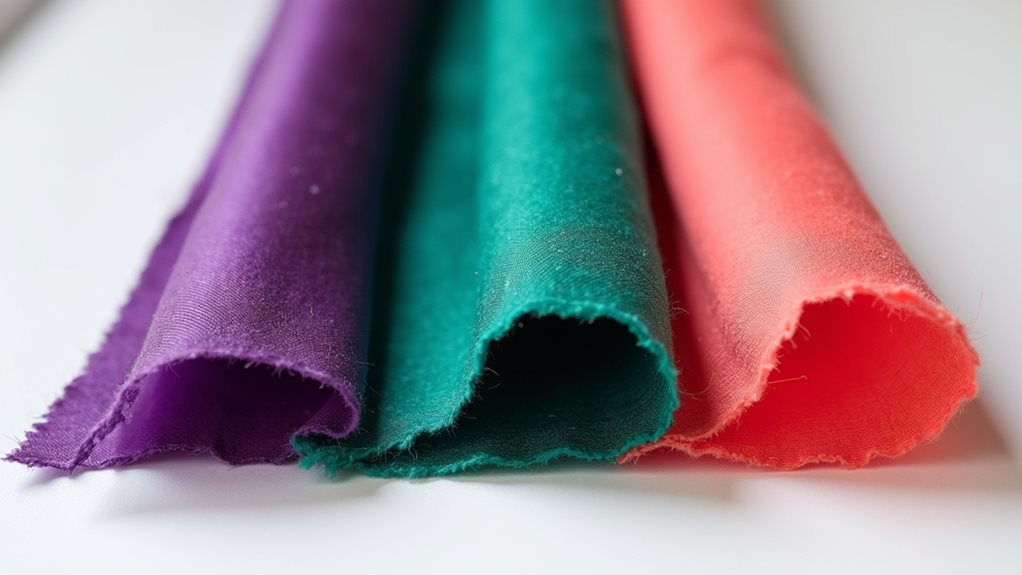
When I learned the hard way that my favorite silk blouse turned into a pale shadow of its former self after one unfortunate washing machine encounter, I discovered that certain fabrics are like delicate flowers when it comes to color retention.
Your natural fibers—silk, wool, and that gorgeous velvet blazer you’ve been eyeing—are basically sitting ducks for fading because their organic structure holds dye differently than synthetic materials, making them vulnerable to color loss even with gentle washing.
Dark cotton shirts and linen pants might seem sturdy, but they’re actually prime candidates for that dreaded washed-out look that transforms your sharp wardrobe into something resembling weekend pajamas 😅.
Dry cleaning uses chemical solvents instead of water to safely remove dirt and stains while preserving the fabric’s integrity and preventing the color bleeding that can occur with traditional washing methods.
Natural Fiber Vulnerability
Since I learned this lesson the hard way with my favorite silk blouse—the one that went from deep emerald to sad seafoam after just one washing machine mishap—I’ve become somewhat obsessed with understanding which fabrics are most vulnerable to fading.
Natural fibers like cotton, silk, and wool are basically sitting ducks when it comes to color loss, and here’s why: their inherent characteristics make them absorb water like little sponges, which then causes dyes to bleed and fade faster than you can say “laundry disaster.” 😅
Dry cleaning uses gentle solvents instead of water, helping preserve those delicate fabrics and maintain their original vibrancy, which is honestly a game-changer for anyone who’s ever mourned a beloved garment.
This chemical solvent process also prevents the structural damage and shrinkage that water-based washing often causes to these vulnerable natural fibers.
Delicate Fabric Types
Although my closet has become a graveyard of fading fashion casualties over the years, I’ve learned that certain delicate fabrics are basically crying out for the gentle touch of dry cleaning to keep their colors intact.
You’ll want to pay special attention to velvet, rayon, and silk—these beauties are notorious for losing their vibrancy when exposed to water and harsh detergents.
I discovered this the hard way with a gorgeous burgundy velvet blazer that turned into a sad, patchy mess after one unfortunate washing machine encounter 😅.
Professional dry cleaners understand how to handle these temperamental materials without causing color retention issues or setting stubborn stains.
Dry cleaning helps preserve the shape, texture, and color of garments while preventing fabric deterioration that often occurs with regular washing.
Trust me, investing in proper care for delicate fabrics saves you heartbreak and money in the long run.
Color-Intensive Materials
While most fabrics can handle a bit of rough treatment, color-intensive materials are the drama queens of your wardrobe, demanding special attention to keep their rich, saturated hues from turning into washed-out shadows of their former selves.
Silk, velvet, and certain synthetics throw absolute tantrums when exposed to water and harsh detergents, making dry cleaning your saving grace for preserving those gorgeous colors.
These fabrics are like that friend who looks amazing but requires constant maintenance – they’re worth it, but you’ve got to treat them right.
The clear, non-reactive solvents used in dry cleaning don’t mess with dyes the way water does, so your vibrant garment stays vibrant instead of becoming a sad, faded version of its former glory.
In contrast, cotton garments are typically machine washable and can handle regular home laundering methods due to the fiber’s natural durability and absorbent properties.
Quality of Solvents and Their Impact on Garment Colors
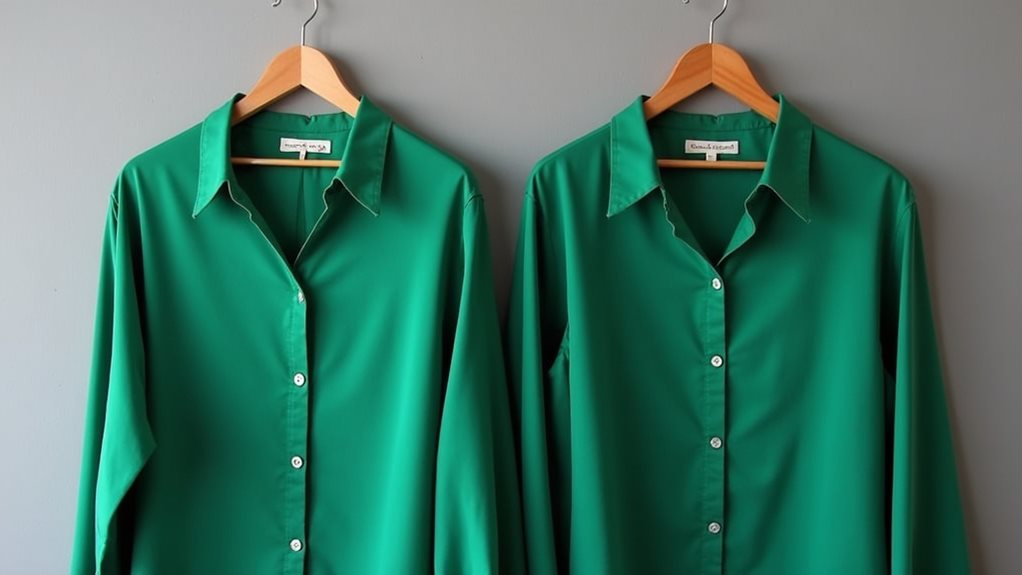
You might think all dry cleaning solvents are created equal, but I learned the hard way when my favorite black blazer came back looking like it had been through a fog machine – dull, lifeless, and somehow grayer than my Monday morning mood ☕.
The truth is, clean solvents versus dirty ones make the difference between preserving your garment’s vibrant colors and watching them slowly fade away, much like how clean water keeps your dishes sparkling while murky dishwater leaves everything looking questionable.
What’s even trickier is that certain solvents can actually react with your fabric’s dyes, creating chemical reactions that’ll have your clothes looking like they’ve been sunbathing for decades when they’ve only been in the cleaning machine for an hour.
While perchloroethylene remains the most commonly used solvent in professional dry cleaning operations, its chemical properties and the condition of the solvent can significantly impact how well your garment’s original colors are preserved during the cleaning process.
Clean Versus Dirty Solvents
When you drop off your favorite black dress or navy suit at the dry cleaner, you’re fundamentally entrusting your garment’s future to the quality of their cleaning solvents.
And trust me, this choice can make or break the vibrancy of your clothes.
Clean solvents remain crystal clear throughout the cleaning process, which means they won’t strip dye from your precious fabrics.
However, dirty or unfiltered solvents tell a different story entirely – they become discolored because they’re literally pulling color from garments, leaving your vibrant pieces looking dull and lifeless.
Professional dry cleaners primarily use perchloroethylene as their main solvent, which effectively dissolves oils and greases while maintaining fabric integrity when properly maintained.
Here’s what separates exceptional dry cleaners from mediocre ones:
- Clean solvents maintain crystal clarity, preserving original garment colors
- Dirty solvents become discolored, indicating harmful dye extraction
- Quality establishments regularly filter and maintain their cleaning solutions
Choose wisely!
Chemical Reactions With Dyes
The real villain behind faded garments isn’t just dirty solvents – it’s the aggressive chemical reactions happening between common cleaning fluids and your garment’s dyes, and frankly, most dry cleaners are using solvents that’ll wage chemical warfare on your favorite pieces.
Here’s what’s actually happening during the dry cleaning process: approximately 95% of cleaners use perchloroethylene and similar reactive solvents that chemically attack garment dyes, causing them to bleed and fade with each cleaning cycle.
You’ll notice this when solvents turn discolored – that’s literally your clothes’ colors being extracted!
Before modern solvents like perchloroethylene became standard, the dry cleaning industry relied on carbon tetrachloride, which was eventually banned due to serious health risks including liver toxicity and carcinogenic effects.
The solution lies in high-quality solvents like siloxane, which remain chemically inert and don’t react with dyes, preventing dulling and preserving your garments’ original vibrancy through countless cleanings.
When Dry Cleaning May Not Prevent Fading
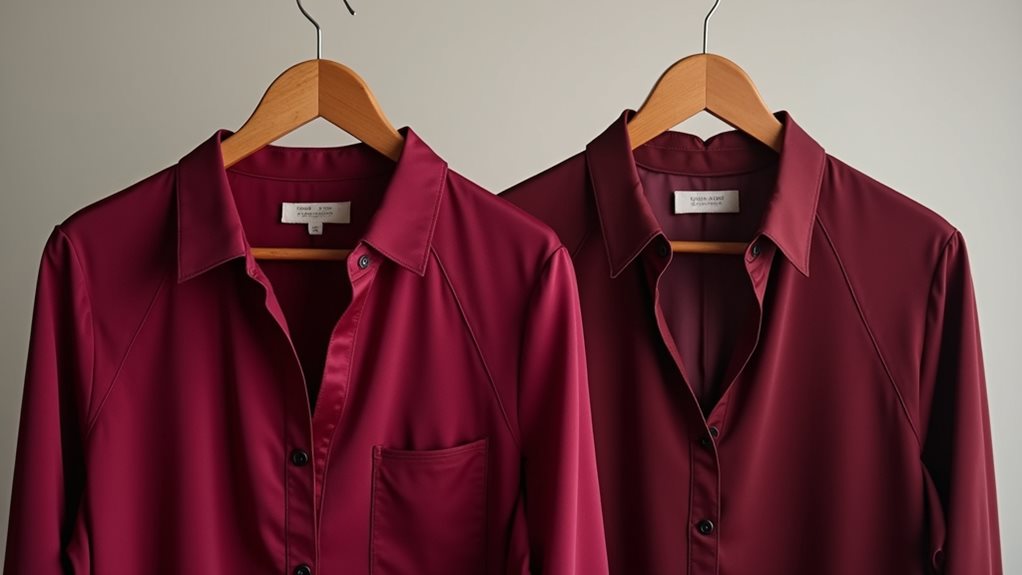
Although dry cleaning has earned a reputation as the gentler alternative to washing machines, it’s not always the fabric-saving hero we’d like it to be. I learned this the hard way when my favorite navy blazer came back looking like it had been through a color-draining nightmare.
Sometimes dry cleaning can actually cause fading, especially when certain conditions align against your garments:
- Chemical reactions occur when cleaning solvent reacts with dyes, causing color bleeding in your fabric.
- Excessive treatments weaken delicate materials over time, making them more susceptible to fading and damage.
- Dirty solvents extract dyes from dark-colored clothes, leaving them looking dull and lifeless.
Even fabrics labeled “dry clean only” aren’t immune to fading if the cleaning method doesn’t suit the specific material type.
Best Practices for Maintaining Vibrant Colors
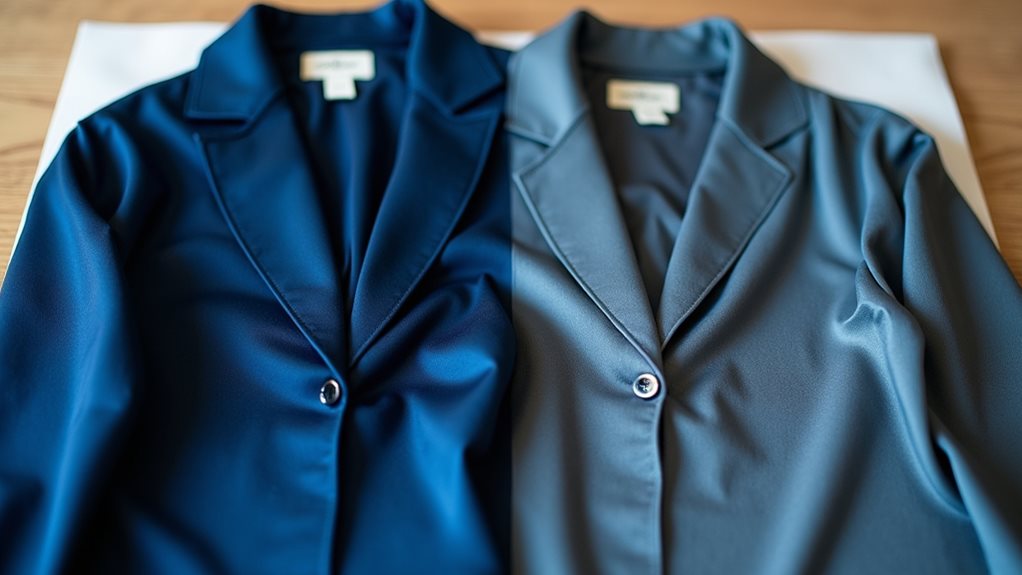
Five simple strategies can transform your relationship with dry cleaning from a color-fading gamble into a vibrant wardrobe preservation system. After losing several beloved pieces to poor cleaning practices, I’ve become somewhat obsessed with finding cleaners who actually know what they’re doing.
First, you’ll want to seek out cleaners using crystal clear, non-reactive solvents that maintain vibrant hues without dulling your favorite pieces.
Second, make sure they’re properly pre-treating stains before cleaning, since untreated spots can oxidize and damage fabric dyes over time.
Third, the removing dirt and stains process should be thorough yet gentle.
Finally, properly store garments in cool, dry places away from sunlight after dry cleaning to prevent fading and preserve that fresh-from-the-cleaner brilliance.

